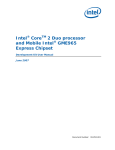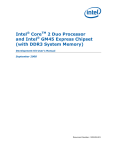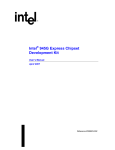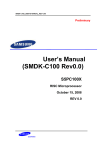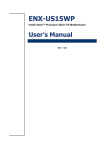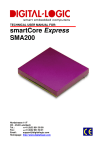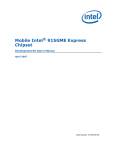Download Intel ATOM US15W User's Manual
Transcript
Intel® Atom™ Processor and Intel® System Controller Hub US15W Development Kit User’s Manual July 2008 Document #: 320264 Revision 1.0 INFORMATION IN THIS DOCUMENT IS PROVIDED IN CONNECTION WITH INTEL® PRODUCTS. NO LICENSE, EXPRESS OR IMPLIED, BY ESTOPPEL OR OTHERWISE, TO ANY INTELLECTUAL PROPERTY RIGHTS IS GRANTED BY THIS DOCUMENT. EXCEPT AS PROVIDED IN INTEL'S TERMS AND CONDITIONS OF SALE FOR SUCH PRODUCTS, INTEL ASSUMES NO LIABILITY WHATSOEVER, AND INTEL DISCLAIMS ANY EXPRESS OR IMPLIED WARRANTY, RELATING TO SALE AND/OR USE OF INTEL PRODUCTS INCLUDING LIABILITY OR WARRANTIES RELATING TO FITNESS FOR A PARTICULAR PURPOSE, MERCHANTABILITY, OR INFRINGEMENT OF ANY PATENT, COPYRIGHT OR OTHER INTELLECTUAL PROPERTY RIGHT. UNLESS OTHERWISE AGREED IN WRITING BY INTEL, THE INTEL PRODUCTS ARE NOT DESIGNED NOR INTENDED FOR ANY APPLICATION IN WHICH THE FAILURE OF THE INTEL PRODUCT COULD CREATE A SITUATION WHERE PERSONAL INJURY OR DEATH MAY OCCUR. Intel may make changes to specifications and product descriptions at any time, without notice. Designers must not rely on the absence or characteristics of any features or instructions marked "reserved" or "undefined." Intel reserves these for future definition and shall have no responsibility whatsoever for conflicts or incompatibilities arising from future changes to them. The information here is subject to change without notice. Do not finalize a design with this information. The products described in this document may contain design defects or errors known as errata which may cause the product to deviate from published specifications. Current characterized errata are available on request. Contact your local Intel sales office or your distributor to obtain the latest specifications and before placing your product order. This document contains information on products in the design phase of development. Intel and the Intel logo are trademarks of Intel Corporation in the U.S. and other countries. *Other names and brands may be claimed as the property of others. Copyright © 2008 Intel Corporation. All rights reserved. User’s Manual 2 Document Number: 320264 Contents 1 Introduction .....................................................................................................7 1.1 1.2 1.3 1.4 1.5 2 Crown Beach Board ......................................................................................... 11 2.1 2.2 2.3 2.4 2.5 3 Power Measurement Support ................................................................. 21 Reference Board Summary ............................................................................... 27 4.1 4.2 4.3 4.4 User’s Manual Getting Started .................................................................................... 12 Overview ............................................................................................ 13 Major Features..................................................................................... 13 Processor Support ................................................................................ 15 2.4.1 Processor Voltage Regulators .................................................... 15 Subsystem Descriptions ........................................................................ 16 2.5.1 Intel® SCH Chipset ................................................................. 16 2.5.2 System Memory ...................................................................... 16 2.5.3 Display .................................................................................. 16 2.5.4 PCI Express* Slots .................................................................. 17 2.5.5 Soft Audio/Soft Modem ............................................................ 17 2.5.6 PATA Storage ......................................................................... 18 2.5.7 USB Connectors ...................................................................... 18 2.5.8 LPC Slot................................................................................. 18 2.5.9 System Management Controller (SMC)/Keyboard Controller (KBC).. 18 2.5.10 EFI Firmware Hub (FWH).......................................................... 19 2.5.11 Trusted Platform Module (TPM) Header....................................... 19 2.5.12 SD/SDIO/MMC ........................................................................ 19 2.5.13 Clocks ................................................................................... 19 2.5.14 Real Time Clock ...................................................................... 19 2.5.15 In-Target Probe (ITP) and Debug Support................................... 20 2.5.16 Power Supply Solution ............................................................. 20 2.5.17 Board Size ............................................................................. 20 2.5.18 Board Technology.................................................................... 20 Power Management......................................................................................... 21 3.1 4 About the Development Kit ......................................................................7 Terminology ..........................................................................................8 Technical Support...................................................................................9 1.3.1 Additional Technical Support .......................................................9 Product Literature ................................................................................ 10 Related Documents .............................................................................. 10 Crown Beach Board Features ................................................................. 27 Connectors.......................................................................................... 27 4.2.1 Back Panel Connectors ............................................................. 28 Configuration Settings........................................................................... 29 4.3.1 Configuration Jumpers/Switches ................................................ 29 BSEL Jumper Settings ........................................................................... 32 3 Document Number: 320264 4.5 4.6 4.7 4.8 4.9 4.10 5 Manual VID Support for CPU .................................................................. 32 Power On and Reset Push Buttons .......................................................... 33 LEDs .................................................................................................. 34 PCI Express* X1 Slots and Mini Card Connectors....................................... 35 4.8.1 Mini Card A connector (J7H1) is enabled by default ...................... 35 4.8.2 Mini Card B connector (J2G1) is disabled by default...................... 36 H8S (JTAG) Programming Headers.......................................................... 36 4.9.1 H8 In-System Programming...................................................... 36 4.9.2 H8 Remote Programming ......................................................... 36 UART Connector ................................................................................... 38 Quick Start .................................................................................................... 39 5.1 5.2 5.3 5.4 Required Peripherals ............................................................................. 39 Graphics Assembly (LVDS Panel) ............................................................ 40 Power Up ............................................................................................ 43 EFI Firmware Updates ........................................................................... 45 Appendix A Daughter and Plug-In Cards ............................................................................. 46 A.1 Mott Canyon 4 Interposer Card ......................................................................... 46 A.1.1 Jumper Settings ............................................................................................. 47 A.1.2 Firmware Configuration.................................................................................... 49 Appendix B Intel® MVP-6 VID Codes.................................................................................. 50 Appendix C External Features............................................................................................ 53 C.1 External Feature Locations ............................................................................... 53 C.1.1 External Feature Location (Front of Chassis) ....................................................... 53 C.1.2 External Feature Location (Rear of Chassis) ........................................................ 54 User’s Manual 4 Document Number: 320264 Figures Figure Figure Figure Figure Figure Figure Figure Figure Figure Figure Figure Figure Figure Figure 1. Crown Beach Board Block Diagram ....................................................... 11 2. Crown Beach Board (Top View)............................................................ 12 3. Crown Beach Board Feature Placement ................................................. 27 4. Back Panel Connectors ....................................................................... 28 5. Location of the Configuration Jumpers/Switches ..................................... 29 6. Crown Beach Manual VID .................................................................... 33 7. Crown Beach Power On and Reset Buttons ............................................ 33 8. Crown Beach LEDs ............................................................................. 35 9. Samsung 15 inch (381.00 mm) Panel ................................................... 40 10. Crown Beach Board .......................................................................... 41 11. LVDS Cable Connected to the Crown Beach Board................................. 42 12. Mott Canyon 4 Interposer Card .......................................................... 47 13. Front Chassis View ........................................................................... 53 14. Rear Chassis View with Board Installed ............................................... 54 Tables Table Table Table Table Table Table Table Table Table Table Table Table Table Table Table Table User’s Manual 1. Intel Literature Centers........................................................................ 10 2. Related Documents. ............................................................................ 10 3. Crown Beach Feature Set Summary....................................................... 13 4. Crown Beach Supported LVDS Displays .................................................. 17 5. Power Measurement Resistor ................................................................ 21 6. Digital Multi-Meter Comparison ............................................................. 21 7. Crown Beach Voltage Rails ................................................................... 22 8. Back Panel Connectors......................................................................... 28 9. Configuration Jumper/Switches Settings................................................. 30 10. BSEL Jumper Settings........................................................................ 32 11. Crown Beach LEDs ............................................................................ 34 12. PCI Express* Slot 1 Board Rework to Enable Functionality....................... 35 13. Mini Card B Board Rework to Enable Functionality .................................. 36 14. H8 Programming Jumpers .................................................................. 38 15. Mott Canyon 4 Interposer Card Configuration Jumper/Switches................ 48 16 Voltage Identification Definition............................................................ 50 5 Document Number: 320264 Revision History Document Number Revision Number Description 394649 1.0 Initial release. 320264 1.0 Release for public posting § User’s Manual 6 Document Number: 320264 Introduction 1 Introduction This manual describes the typical hardware set-up procedures, features, and use of the evaluation board and other components included in the Intel® Atom™ processor and Intel® System Controller Hub US15W Development Kit. This reference board supports the Intel® Atom™ processor and Intel® System Controller Hub (Intel® SCH). Note: Read this document in its entirety prior to applying power to the motherboard. Intel recommends having both the schematic and board present while reading this document. The references in this document correlate to reference designators and board properties of Crown Beach FAB F Customer Reference Board. This manual is intended to be used with the Development Kit but can also be used to help bring up a Crown Beach Board, although not all associated peripherals will be included with a board. 1.1 About the Development Kit The development kit includes the following: • Crown Beach Customer Reference Board with Intel® Atom™ processor Z530 1.6GHz and Intel® System Controller Hub US15W • Pre-installed jumpers • FWH mounted and flashed with EFI • 1 GB DDR2 SO-DIMM • VGA SDVO ADD2N Card • 80 GB Hard Drive with MIDINUX Embedded OS • DVD-ROM Drive • IDE cable • Mott Canyon 4 with Intel® High Definition Audio (Intel® HD Audio) card • Intel® 82574L Gigabit Ethernet Controller • CD with Chipset and Intel® Embedded Graphics Drivers (IEGD) • Chassis with ATX power supply Note: Please refer to Section 5.4 for the location of latest appropriate EFI firmware and driver updates. User’s Manual 7 Document Number: 320264 Introduction Note: Not all peripherals listed will be included with a Crown Beach board. 1.2 Terminology Term User’s Manual Definition ACPI Advanced Configuration Power Interface ADD2 Advanced Digital display 2 card ADD2R Advanced Digital display 2 card with PCI-E graphics lane reversed (not supported on Crown Beach) CRB Customer Reference Board BGA Ball Grid Array DDR Double Data Rate DMA Direct Memory Access Duck Bay 3 PCI Express* interposer card that provides ExpressCard* support for Crown Beach CRB EFI Extensible Firmware Interface FAE Field Application Engineer FSB Front Side Bus FWH Firmware Hub GPIO General Purpose Input Output IDE Integrated Device Electronics IEGD Intel® Embedded Graphics Driver IMVP Intel® Mobile Voltage Positioning Intel® HD Audio Intel® High Definition Audio Mott Canyon 4 This Add-in Card enables Intel® HD Audio functionality Intel® SCH Intel® System Controller Hub ITP In-Target Probe JEDEC Joint Electron Device Engineering Council KBC Keyboard Controller LAN Local Area Network LED Light Emitting Diode LPC Low Pin Count LVDS Low Voltage Differential Signaling MDC Mobile Daughter Card 8 Document Number: 320264 Introduction Term 1.3 Definition OS Operating System PATA Parallel AT Attachment PC Personal Computer PCB Printed Circuit Board PCIe* PCI Express* PEG PCI Express* Graphics PLL Phase Lock Loop PGA Pin Grid Array RTC Real Time Clock SCH System Controller Hub SD Secure Digital SDVO Serial Digital Video Output SIO Super Input Output SMC System Management Controller SO-DIMM Small Outline Dual In-line Memory Module TPM Trusted Platform Module TSSOP Thin Shrink Small Outline Package USB Universal Serial Bus VGA Video Graphics Array VID Voltage Identification VR Voltage Regulator XDP Extended Debug Port Technical Support Support Services for your hardware and software are provided through the secure Intel® Premier Support Web site at https://premier.intel.com. After you log on, you can obtain technical support, review “What’s New,” and download any items required to maintain the platform. Support is provided through the following product: Dev Kit (Embedded/Atom/US15W). 1.3.1 Additional Technical Support If you require additional technical support, please contact your field sales representative or local distributor. User’s Manual 9 Document Number: 320264 Introduction 1.4 Product Literature You can order product literature from the following Intel literature centers. Table 1. Intel Literature Centers 1.5 U.S and Canada 1-800-548-4725 U.S. (from overseas) 708-296-9333 Europe (U.K.) 44(0)1793-431155 Germany 44(0)1793-421333 France 44(0)1793-421777 Japan (fax only) 81(0)120-47-88-32 Related Documents Table 2 is a partial list of the available collateral. For the complete list, contact your local Intel representative. Table 2. Related Documents. Document Document Numbers/ Location Processor and SCH-Related Documents Intel® Centrino® Atom™ Processor Technology Platform Design Guide Contact your FAE for the latest revision Menlow Platform Crown Beach Customer Reference Board Schematic Menlow Platform – Ballout, Signal, and Mechanical Package Intel® Atom™ Processor Z5xx Series Datasheet Intel® System Controller Hub (Intel® SCH) Datasheet Intel® Atom™ Processor Z5xx Series Specification Update Intel® System Controller Hub (Intel® SCH) Specification Update Firmware-Related Documents Aptio 4.x Whitepaper User’s Manual www.ami.com/aptio/ 10 Document Number: 320264 Crown Beach Board 2 Crown Beach Board Figure 1. Crown Beach Board Block Diagram User’s Manual 11 Document Number: 320264 Crown Beach Board Figure 2. Crown Beach Board (Top View) 2.1 Getting Started This section identifies the key components, features and specifications of the Intel® Atom™ processor with Intel® System Controller Hub US15W Development Kit. It also describes how to set up the board for operation. Development software is included in the kit. User’s Manual 12 Document Number: 320264 Crown Beach Board Note: This manual assumes a familiarity with basic concepts involved with installing and configuring hardware for a PC. 2.2 Overview The development kit contains a baseboard with an Intel® Atom™ processor Z530, Intel® System Controller Hub US15W, other system board components and peripheral connectors. Note: The evaluation board is shipped in a closed chassis. The user is required to observe extra precautions if the user opens the chassis for any reason. Note: Review the document provided with the Development Kit titled Important Safety and Regulatory Information. This document contains additional safety warnings and cautions. 2.3 Major Features Table 3 is a list of the major features for the customer reference board. Table 3. Crown Beach Feature Set Summary Feature Comments Processor Intel® Atom™ processor Z530 with 512KB L2 cache 0.55 x 0.52 inch (14 X 13 mm) FCBGA package with 0.0024 inch (0.6 mm) ball pitch and 441-pins. CPU Voltage Regulator Intel® Mobile Voltage Positioning 6 (Intel® MVP6) 1 Phase Chipset Intel® SCH US15W 0.87 x 0.87 inch (22 X 22-mm) FCBGA package with 0.0024 inch (0.6-mm) ball pitch and 1249-pins. Board Technology High Density Interconnect, Type IV; 1-6-1 stackup S-G-S-G-Core-G-S-G-S stackup Board Size µATX 9.6 x 10.4 inch (243.84 x 264.16 mm) Doubled-sided placement Memory Single top-side SO-DIMM connector for single-channel, single or dual rank Supports up to 2-GB of system memory. 8 SDRAM devices max One x16 single-channel SDVO card slot. Supports ADD2N cards. No integrated VGA support is available on the Crown Beach CRB. One LVDS Connector VGA supported through ADD2N Card. Graphics User’s Manual Crown Beach Board Implementation 13 Document Number: 320264 Crown Beach Board Feature Crown Beach Board Implementation Comments Through a 50-pin cable-up connector (separate cables required for each display supported). LVDS options Single 24-bit LVDS interface; Back Light Inverter (BLI) and LED backlight support Main Clock CK540 Integrated CK-SSCD and clock expansion buffer. ATA/Storage PATA66/100 One desktop PATA connector TSSOP, 64-pinspackage 4 back panel connectors • Ports [1:0] and [4:3] 3 cable-up • Ports [5] and [7:6] USB 8 USB 2.0 ports One client-mode back panel connector (mini-B). • Port [2] NOTE: All ports are enabled by default except port 5. For more information, refer Section 2.5.7 USB Connectors. NOTE: Ports [7:6] are USB 2.0 only. 2 SDIO back panel connectors • Slot [2:1] SDIO/MMC 2 ports (Ports 0 and 1), 4-bits 1 port (Port 2), 8-bits One SDIO backside connector • Slot [0] All slots are SDIO Revision 1.1 and MMC Revision 4.0 compliant NOTE: Soft Audio/ Soft Modem 2 x8 option for cable-up to SDVO for HDMI+ One Intel® HD Audio MDC Header For more information, refer to Section 2.5.12 SD/SDIO/MMC. Option for 3.3-V and 1.5-V operation through jumper. 2 x4 for Mott Canyon 4 support x1 connector PCI Express* x1 connector User’s Manual Revision 1.0a compliant 2 connectors NOTE: Slot 1 is non-functional by default. 14 Document Number: 320264 Crown Beach Board Feature Crown Beach Board Implementation Comments 2 connectors. PCI Express* Mini Card connector NOTE: NOTE: PCI Express* signals are left unconnected on Mini Card B. For more information, refer to Section 2.5.4, PCI Express* Slots. LPC One LPC slot TPM Through TPM header (TPM 1.2) Microcontroller Renesas Technology* H8S/2117 Includes integrated SPI as an option FWH FWH LPC based with socket 40-pin TSSOP socket SIO Uses TPM header Backup only; provides floppy, COM, Parallel, and PS2 SMC/KBC Scan matrix headers and PS/2 in back panel keyboard connector ACPI compliant through H8S/2117 RTC Battery-backed real time clock Port 80 Decode Supported down on motherboard with four seven-segment displays Has an option for cable-up to front panel of chassis Desktop Mode ATX Power Supply Virtual Battery SW8A1 switch Extended Debug Port (XDP) J1E3 XDP connector ACPI Compliant S0 S3 S4 S5 Power Supply ITP Support Power Management Form Factor 2.4 Mini Card connector A, functionality is enabled by default. No DMA support – – – – Power On Suspend to RAM Suspend to Disk Soft Off Processor Support The reference board supports the Intel® Atom™ processor Z530 with 512-KB cache in a 441-pin, FCBGA package. No heatsink is required by this processor during room temperature ambient operation. 2.4.1 Processor Voltage Regulators The reference board uses an onboard Intel® MVP6 single-phase regulator for the processor core supply. The I/O voltage is 1.05 V. See Section 4.5 for VID jumper location and Appendix B for the VID code table. User’s Manual 15 Document Number: 320264 Crown Beach Board 2.5 Subsystem Descriptions Subsystem features refer to the socket and connector locations on the Crown Beach Board. Socket and connector locations are labeled with a letter-number combination. Refer to the silkscreen labeling on Crown Beach Board for location detail. 2.5.1 2.5.2 Intel® SCH Chipset • Processor interface at 400/533 MHz • Single channel DDR2 memory interface running at 400/533 MT/s • Two PCI Express* ports, x1 • Eight USB 2.0 compatible ports • One ATAPI-6 (UDMA 100MB/s) IDE channel • Intel® HD Audio • Three SDIO/MMC interfaces • One channel 24-bit LVDS • One channel SDVO • LPC bus System Memory • Supports a single DDR2 SO-DIMM socket. SO-DIMMs must be un-buffered and compliant with Raw Cards A or C as defined by JEDEC. • Supports 400- or 533-MHz memory bus frequencies. Note: SO-DIMM support is only provided for validation purposes. The Intel® Centrino® Atom™ Processor Technology Platform Design Guide provides component implementations for memory down solutions. The DDR2 SODIMM Architecture’s Implementation for Intel® System Controller Hub (SCH) US15W whitepaper provides guidelines for implementing a SO-DIMM solution, although the recommendations are based on simulation only and have not been validated. It is recommended that customers validate their designs. 2.5.3 Display The reference board has two options for displaying video: • LVDS – location is J5G2 • SDVO – location is J7C2 Note: The customer reference board supports single channel LVDS only. Table 4 is a listing of displays that have been tested with Crown Beach. User’s Manual 16 Document Number: 320264 Crown Beach Board Table 4. Crown Beach Supported LVDS Displays Manufacturer /Type 2.5.4 Size Resolution Back Light Aspect Ratio Part# Samsung 4.8 inch (121.92 mm) 1024 x 600 11 LED 16 x 9 LTS480WS-C01 TMD 5.6 inch (142.24 mm) 1024 x 600 CCFL 16 x 9 LTD056ET0S Sharp 7.2 inch (182.88 mm) 1280 x 768 32 LED 15 x 9 LQ072K1LA08 Samsung 15 inch (381.00 mm) 1024 x 768 CCFL 4x3 LTN150XG-L08 NEC 8.4 inch (213.36 mm) 640 x 480 2 CCFL 4x3 NL6448BC26-08D NEC 9.0 inch (228.60 mm) 800 x 480 2 CCFL 15 x 9 N8048BC24-06 TMD 11.1 inch (281.94 mm) 1366 x 768 CCFL 16 x 9 LTD111EXCS Samsung 15.4 inch (391.16 mm) 1280 x 800 CCFL 15 x 9 LTN154X5-L06 NOTE: The protective tape on top of the Crown Beach LVDS connector must be removed prior to installing an LVDS cable. NOTE: VGA output is not directly supported. Customers can use PCI Express*-based discrete, external 3D graphics cards, or a third-party component available on an ADD2N card using the SDVO interface. PCI Express* Slots • Two PCI Express* slots x1 for add-in cards. • The PCI Express* bus complies with the PCI Express* Rev. 1.0a specification. Crown Beach provides two PCI Express* Mini Card form factor slots. The PCI Express* specification pin-out is followed by Mini Card Slot A only and not by Mini Card Slot B. Mini Card Slot A is enabled by default and to enable Mini Card Slot B, rework needs to be performed. The slots are not to be used with PCI Express* Mini Card-based devices. Mini Card A (J7H1) is designed for use with CM100/CM101 cards from Quanta. Mini Card A can be populated with the Kedron, Echo Peak, or Shirley Peak wireless cards. Mini Card B (J2G1) is designed for use with Wireless WAN cards from Sierra Wireless* and Option*. 2.5.5 Soft Audio/Soft Modem High Definition Soft Audio/Soft Modem functionality is enabled through the Mott Canyon 4 daughter card. No direct connection is provided for Intel® HD Audio on User’s Manual 17 Document Number: 320264 Crown Beach Board Crown Beach. The Mott Canyon 4 card is required to enable the High Definition Audio functionality. See Appendix A for more information on the Mott Canyon 4 card. 2.5.6 PATA Storage The Crown Beach Board provides only one desktop, 40-pin, PATA66/100 connector that supports master and slave devices. 2.5.7 USB Connectors The Intel® SCH provides eight USB 2.0 ports. • Four ports are routed to the back panel’s two stacked USB connectors. USB ports [1:0] and [4:3] are routed to the back of the chassis. • Port 2 is the client-mode connector and is routed to the back of the chassis with a Mini-B connector. • Ports [7:5] are routed to the front panel headers (USB FPIO, Duck Bay, and Sideband Header) and to the Sideband headers (Duck Bay, Upham USB). • For wireless solutions port 0 is also used with stuffing options for the PCI Express* Mini Card. OC [7:0] # is available for over-current detection. • Port 5 is disabled by default due to enabling of PCI Express* Mini Card A Slot. Note: USB port 0 functionality is impacted if rework is performed to enable the PCI Express* Mini Card B Slot. 2.5.8 LPC Slot The H8S/2117 serves as a keyboard controller on the customer reference board. Note: Other solutions, such as a mouse controller, can be tested in the LPC slot while H8S is held in reset. 2.5.9 • LPC slot and sideband header are supported. • Docking and DMA are not supported by the Intel® SCH on Crown Beach. • Port 80-83 is implemented using the EPM7064AE device down on the motherboard with 4, seven-segment displays on the LPC bus. • An option for connecting the cable to front panel or chassis is available. System Management Controller (SMC)/Keyboard Controller (KBC) Renesas Technology* H8S serves as both SMC and KBC for the platform. The SMC/KBC controller supports: User’s Manual 18 Document Number: 320264 Crown Beach Board • Two PS/2 ports. Note: The two PS/2 ports are for a legacy keyboard and mouse. The keyboard plugs into the bottom port and the mouse plugs into the top port. 2.5.10 • EMA support • Wake/runtime SCI events • Power sequencing control EFI Firmware Hub (FWH) A TSOP socket houses the flash device (ST Microelectronics P/N# M50FW080) that stores the system EFI firmware. The EFI firmware can be programmed through a Microsoft MS-DOS* or Windows*-based utility. 2.5.11 Trusted Platform Module (TPM) Header Crown Beach implements a header at J9B4 to support TPM 1.2 specification compliant devices. The same header can be used for legacy connections, allowing other SIO solutions to provide floppy, COM, Parallel, and PS/2 functionality. 2.5.12 SD/SDIO/MMC Crown Beach provides three ports with the following features: 2.5.13 • All ports are SD rev1.1 specification compliant and MMC rev4.0 specification compliant. • All ports operate to 48 MHz. Ports 0 and 1 support 4-bit operation. Port 2 supports 8-bit operation. • Slot 2 is also routed (with stuffing options) to the PCI Express* Mini Card for wireless solutions. Clocks The Crown Beach CRB uses a CK-540 clock solution. The BSEL [2:1] signals driven by the processor are used by the CK-540 to configure the FSB frequency. 2.5.14 Real Time Clock An on-board battery maintains power to the real time clock (RTC) when in a mechanical off state (G3 state). User’s Manual 19 Document Number: 320264 Crown Beach Board 2.5.15 In-Target Probe (ITP) and Debug Support Crown Beach provides on-board ITP support with an XDP connector. Users can debug from the reset vector without EFI or OS dependency (up to OS functionality). Ports 80-83 are provided as a troubleshooting tool to monitor POST output during EFI execution. Note: ITP requires that the CMC load to configure Poulsbo before register accesses can be made. The CMC code resides in the FWH on Crown Beach. Thus, it is required that the FWH flash be programmed and inserted in the FWH socket to use ITP. Note: Crown Beach does not support ITP 700. 2.5.16 Power Supply Solution Crown Beach can be powered from an ATX power supply (desktop solution) that contains all of the voltage regulators necessary to power the system up. Additionally, virtual battery support is provided through switch SW8A1. Note: Use an “ATX12V” 1.1 specification compliant power supply regardless of supplier or wattage level (an "ATX12V" rating means V5 min current =0.1 A, "ATX" V5 min current = 1.0 A, among other differences). For example, the Sparkle Model No. FSP300-60BTV meets this requirement and is an ATX12V 1.1 spec compliant power supply. Depending on the power supply used, Crown Beach may require a load. Crown Beach provides FETS to assist with this loading through jumpers J4J1 and J5J2, see Table 9 for jumper settings. Note: If the power switch on the ATX power supply is used to shut down the system, wait at least 5 seconds before turning the system on again. Note: The recommended way to shut down the board is to press and hold the power button switch (SW3J1) for 5 seconds until the power supply turns off. Using the power supply switch or pulling the plug out of the wall is not recommended. 2.5.17 Board Size The reference board form factor is similar to the µATX 9.6 x 10.4 inch (243.84 x 264.16 mm) specification. The back panel jacks may not conform to ATX specifications. 2.5.18 Board Technology The Crown Beach reference board uses fine pitched BGA packages, down to 0.0024 inch (0.6 mm) pitch. Type IV high density-interconnect technology is required for breakout purposes and implemented using a 1-6-1 stack-up (8 layers total). § User’s Manual 20 Document Number: 320264 Power Management 3 Power Management 3.1 Power Measurement Support Power measurement resistors are provided to measure the power on many of the subsystems. Table 5. Power Measurement Resistor NOTE: Feature Value Tolerance 1% Value 10 mΩ Intel recommends that larger (~10 mΩ) resistors be stuffed for greater accuracy. Power on a particular subsystem is calculated using the following formula: Equation 1. V2 P= R R = value of the sense resistor (typically 0.01 Ω) V = the voltage difference measured across the sense resistor. Use a high precision digital multi-meter tool such as the Agilent 34401A digital multimeter. Refer to Table 6 for a comparison of a high-precision, digital multi-meter (Agilent 34401A) versus a precision, digital multi-meter (Fluke 79). Table 6. Digital Multi-Meter Comparison Example System Sense Resistor Value Voltage Difference Across Resistor Calculated Power User’s Manual 0.01 Ω 1.492 mV (149.2 mA) 0.223 mW 21 Document Number: 320264 Power Management Agilent 34401A (6½ digit display) Fluke 79 (3 digit display) (±0.0030 % of reading) ±0.09% ±2 digits Specification + (±0.0030 % of range) Min Voltage displayed 1.49193 mV 1.47 mV Calculated power 0.22258 mW 0.216 mW Max voltage displayed 1.49206 mV 1.51 mV Calculated power 0.22624 mW 0.228 mW ±0.009 % ±0.3 % Error in power NOTE: The precision achieved by using a high precision digital multi-meter versus a normal digital multi-meter is ~33 times more accurate. Table 7 summarizes all the power measurement sense resistors located on the Crown Beach board. All sense resistors are 0.01 Ω unless otherwise noted. Component Voltage Supply Rail Ref Des Resistor 11 SCH 1.8 V +V1.8 +V1.8_SM_SCH R5T3 0.01, 1% DDR2_VR 11 SCH 1.05 V +V1.05S_SCH +V1.05S_SCH_VCORE R6T7 0.01, 1% VCORE 11 SCH 1.5 V +V1.5S_SCH +V1.5S_DLVDS_SCH R6T9 0.01, 1% LVDS 11 SCH 3.3 V +V3.3 +V3.3_SCH_SUS R6T13 0.01, 1% SUS 11 SCH 3.3 V +V3.3S +V3.3S_SCH R5T5 0.01, 1% 3.3 V 11 SCH 1.05 V +V1.05S_VTT +V1.05S_VTT_SCH R5U35 0.01, 1% VTT SCH 11 SCH 1.5 V +V1.5S +V1.5S_SCH R5T6 0.01, 1% 1.5CORE 11 SCH 1.5 V +V1.5S_SCH +V1.5S_SDVO_SCH R6T10 0.01, 1% SDVO 11 SCH 1.05 V +V1.05S_VTT +V1.05S_VTT_CPU R3U1 0.01, 1% VTT CPU User’s Manual Supply Power Topology Sch Page Table 7. Crown Beach Voltage Rails 22 Document Number: 320264 Component Voltage Supply Rail Ref Des Resistor 11 SCH 1.5 V +V1.5S_SCH +V1.5S_PCIe_SCH R6T6 0.01, 1% PCIe* 11 SCH 1.8 V +V1.8 +V1.8_SM_SCH R5T3 0.01, 1% DDR2_VR R6T1 0.01, 1% PLLs Supply Power Topology Sch Page Power Management 12 SCH 1.5 V +V1.5S_SCH +V1.5S_DPLLA_SCH, +V1.5S_DPLLB_SCH, +V1.5S_PCIePLL_SCH, +V1.5S_HPLL_SCH, +V1.5S_AUSBPLL_SCH 14 mini PCIe 1.5 V +V1.5S V1.5S_MINIPCIE R7W9 0.01, 1% 1.5-V mini PCIe 14 mini PCIe 3.3 V +V3.3 V3.3_MINIPCIE R9F1 0.01, 1% 3.3-V aux mini PCIe 15 SDVO 3.3 V +V3.3S V3.3S_SDVO R7C1 0.01, 1% 3.3-V SDVO 16 SDVO 12 V +V12S V12S_SDVO R7B3 0.01, 1% 12-V SDVO 17 LVDS 3.3 V +V3.3S V3.3S_LVDS_DDC R5V21 0.01, 1% 3.3-V LVDS_DDC 17 LVDS 5V +V5S V3.3S_LVDSBKLT R5V14 0.01, 1% 5-V LVDS_BCKLT 17 LVDS 12 V +V12S V12S_LVDSBKLT R5V17 0.01, 1% 12-V LVDS_BCKLT 17 LVDS 3.3 V +V3.3S V3.3S_LVDS_VDL R5V28 0.01, 1% 3.3-V LVDS_VDL 18 SO_DIMM 1.8 V +V1.8 +V1.8_DIMM R6R2 0.01, 1% SO-DIMM_DDR2 20 FHW 3.3 V +V3.3S +V3.3S_FWH R7H5 0.01, 1% 3.3-V_FWH 21 TPM 5V +V5 V5_TPM R8N4 0.01, 1% 5-V TPM HEADER 21 TPM 3.3 V +V3.3 V3.3A_TPM R8P2 0.01, 1% 3.3-V TPM HEADER 21 MDC, Audio 3.3 V +VCCHDA VCCHDA_R R8U3 0.01, 1% 3.3V MDC HEADER 21 MDC, Audio 1.5 V/ 3.3 V +V1.5S/+V3.3S VCC_MDC R9E1 0.01, 1% 1.5-V/3.3-V MDC HEADER User’s Manual 23 Document Number: 320264 Component Voltage Supply Rail Ref Des Resistor 21 TPM 3.3 V +V3.3S V3.3S_TPM R8P1 0.01, 1% 3.3-V TPM HEADER 22 PCIe, slot0 12 V +V12_SLOTS V12S_PCIE_SLOT0 R8B1 0.01, 1% 12-V PCIe slot 0 22 PCIe, slot0 3.3 V +V3.3_SLOTS V3.3S_PCIE_ SLOT0 R8C2 0.01, 1% 3.3-V PCIe slot 0 22 PCIe, slot1 12 V +V12_SLOTS V12S_PCIE_ SLOT1 R8B3 0.01, 1% 12-V PCIe slot 1 22 PCIe, slot1 3.3 V +V3.3_SLOTS V3.3S_PCIE_ SLOT1 R8C5 0.01, 1% 3.3-V PCIe slot 1 22 PCIe, slot0 3.3 V +V3.3 V3.3_PCIE_ SLOT0 R8C6 0.01, 1% 3.3-V AUX PCIe slot 0 22 PCIe, slot1 3.3 V +V3.3 V3.3_PCIE_ SLOT 1 R8C7 0.01, 1% 3.3-V AUX PCIe slot 1 23 USB 5V +V5 +V5_USB_P6_P7 R6H2 0.01, 1% 5-V USB Port 6 and 7 23 USB 5V +V5 +V5_USB_P5 R6H3 0.01, 1% 5-V USB Port 5 24 CK540 3.3 V +V3.3S V3.3S_CK505 R8U1 0.01, 1% 3.3-V CK505 25 SDIO1 3.3 V V3.3S_SDIO_ SLOT1 V3.3S_SDIO1 R5M1 0.01, 1% 3.3-V SDIO 1 25 SDIO0 3.3 V V3.3S_SDIO_ SLOT0 V3.3S_SDIO0 R6N1 0.01, 1% 3.3-V SDIO 0 25 SDIO2 3.3 V V3.3S_SDIO_ SLOT2 V3.3S_SDIO2 R4B1 0.01, 1% 3.3-V SDIO 2 27 H8/ Keyboard 3.3 V +V3.3A +V3.3A_KBC R7E2 0.01, 1% 3.3-V KEYBOARD 31 HD Conn 5V +V5S +V5S_PATA R3J1 0.01, 1% 5-V HD Connector R2N1 0.01, 1% 5-V USB Port 0 and 1 (Back Panel) R3N1 0.01, 1% 5-V USB Port 3 and 4 (Back Panel) 32 32 USB USB User’s Manual 5V 5V +V5 +V5 +V5_USB_P0_P1 +V5_USB_P3_P4 Supply Power Topology Sch Page Power Management 24 Document Number: 320264 +V12S V1.05B_INPUT Ref Des Rail Supply Voltage 12 V R5G1 Supply Power Topology 1.05-V Dual VR (2) Resistor 33 Component Sch Page Power Management 0.01, 1% 1.05-V Dual VR (1) --> +V1.05S_VTT, +V1.05S_VTT_C PU 33 1.05-V Dual VR (1) 12 V +V12S V1.05A_INPUT R5V9 0.01, 1% 1.05-V Dual VR (2) --> +V1.05S_SCH, +V1.05S_SCH_ VCORE 36 1.8-V VR (1) 12 V +V12 V12_1.8_INPUT R5C16 0.01, 1% 1.8-V VR (1) -> +V1.8 36 0.9-V VR (2) 12 V +V0.9S V0.9S_DDR2 R5R2 0.01, 1% 1.8-V VR (2) -> +V0.9 38 1.5-V VR 3.3 V +V3.3S V3.3S_1.5_INPUT R5F18 0.01, 1% 1.5-V VR --> +V1.5S 39 3.3-V VR 3.3 V +V3.3A 51120VBST2_LR R4G14 0.002, 1% 3.3-V VR 39 3.3-V VR 3.3 V +V12A V12A_3.3A_INPUT R3W1 0.01, 1% 3.3-V VR 39 5-V VR 5V +V12A V12A_5A_INPUT R4W4 0.01, 1% 5-V VR 39 5V VR 5V +V5A 51120_+V5A_MBL_QL R4H3 0.002, 1% 5-V VR 41 Intel® MVP-6 5V +V5S V5S_IMVP_IN R3C9 0.01, 1% 42 Intel® MVP-6 12 V +V12S_CPU V12_CPU_PHASE R2R8 44 ATX Conn 12 V +V12A +V12_ATX R1J3 0.002, 5% 45 S4 5V +V5 +V5A R4G9 0.01, 1% 5 V, S4 45 S4 3.3 V +V3.3 +V3.3A R4G12 0.01, 1% 3.3 V, S4 45 S3 5V +V5S +V5A R4F4 0.002, 1% 45 S3 3.3 V +V3.3S +V3.3A R4G10 0.01, 1% User’s Manual 0.002, 5% Intel MVP-6 Intel MVP-6 12-V ATX conn 5 V, S3 3.3 V, S3 25 Document Number: 320264 Component Voltage Supply Rail Ref Des Resistor 45 S3 12 V +V12S +V12S_CPU R1H2 0.01, 1% Supply Power Topology Sch Page Power Management 12 V, S3 § User’s Manual 26 Document Number: 320264 Reference Board Summary 4 Reference Board Summary 4.1 Crown Beach Board Features Figure 3. Crown Beach Board Feature Placement Note: The actual labeling on the board is Port 80 and 81. 4.2 Connectors Many of the connectors supply operating voltages of (+5V DC and +12V DC) to devices inside the computer chassis, such as fans and internal peripherals. Caution: User’s Manual Most of these connectors are not over-current protected. Do not use these connectors for powering devices external to the computer chassis. A fault in the load presented 27 Document Number: 320264 Reference Board Summary by the external devices could damage the computer, the interconnecting cable, or the attached external device. 4.2.1 Back Panel Connectors This section describes the board’s connectors. Figure 4 shows the location of the back panel connectors on the board. Figure 4. Back Panel Connectors Note: Connector J1A1 USB Client is a USB 2.0 Mini-B connector. Table 8. Back Panel Connectors Ref Des Description Back Panel Connector PS/2 connector J1A2 Top: Mouse Bottom: Keyboard J1A1 USB Client connector, Port 2 USB Host ports with over-current detection J2A1 Top: Port 0 Bottom : Port 1 USB Host ports with over-current detection User’s Manual J3A1 Top: Port 4 Bottom : Port 3 J4B1 8-bit SD/SDIO/MMC Slot 2 J5B1 4-bit SD/SDIO/MMC Slot 1 28 Document Number: 320264 Reference Board Summary 4.3 Configuration Settings 4.3.1 Configuration Jumpers/Switches Caution: Do not move jumpers with the power on. Switches may be moved while power is on. Always turn off the power and unplug the power cord from the computer before changing jumper settings. Otherwise, damage to the board could occur. Figure 5 shows the location of the major configuration jumpers and switches. Table 9 summarizes the jumpers and switches and gives their default and optional settings. The Crown Beach board is shipped with the jumpers and switches shunted in the default locations. Figure 5. Location of the Configuration Jumpers/Switches User’s Manual 29 Document Number: 320264 Reference Board Summary Table 9. Configuration Jumper/Switches Settings # Description Default Setting1 Reference Designator J8E1 1a Remote H8 Programming Open 1-2 (Short) – to program H8 3 1b Remote H8 Programming (BB_PROG) 1-2 – normal operation 1-x – link the Host Unit to On Board H8 J8D4 2-3 (DOWN) – Virtual Battery switch is pulled low. This enables the virtual battery and the system acts as if it is running from a battery source SW8A1 1-2 (IN) – Override switch SW9A2 condition. System will always act as if it is running from a battery source J8A1 1-2 (IN) - Override switch condition, pulled low J9A1 2-3 (DOWN) – LID switch is pulled low SW9A1 1-2 (UP) – normal operation 2 Virtual Battery Switch 3 Virtual Battery Jumper 4 Lid Jumper Virtual Battery switch is pulled high (disabled). The system acts as if it is running on AC power 1-x (OUT) – normal operation Virtual battery status is controlled by SW9A2 1-x (OUT) – normal operation No effect on circuit. 1-2 (UP) – normal operation J8E4 5 Lid Switch 6 Clear RTC 1-x (OUT) – normal operation 1-2 (IN) to clear CMOS J4H1 7 Force Shutdown No Stuff Reserved J7G1 8a BSEL0 Setting No Stuff Reserved J8G2 8b BSEL1 Setting 1-2 – Processor BSEL Select OUT – 400 MHz 8c BSEL2 Setting 1-2 – Processor BSEL Select 2-3 – 400 MHz Manual VIDs: IN – normal operation VID VID VID VID VID VID VID (1-2) (3-4) (5-6) (7-8) (9-10) (11-12) (13-14) 9a User’s Manual Optional Setting 6 5 4 3 2 1 0 (1-2) (3-4) (5-6) (7-8) (9-10) (11-12) (13-14) LID switch is pulled high OUT – 533 MHz OUT – 533 MHz OUT – Refer to Section 4.5 and Appendix B 2 2 J8G3 J9G3 J1B1 30 Document Number: 320264 Reference Board Summary # Description Default Setting1 Optional Setting 15-16 (IN) – Override to allow manual VID operation Reference Designator 9b VID CPU Override4 (15-16) 10a CFG0 Setting Refer to Section 4.4 J6F1 10b CFG1 Setting Refer to Section 4.4 J7F2 11 Reserved OUT – normal operation Reserved J7F1 12 PS_ON# 1-2 – normal operation 2-3 - Reserved J7H4 13 5V FET Load Disable 1-X (OUT) load 1-2 (IN) no load J4J1 14 12V FET Load Disable 1-2 (IN) no load 1-X (OUT) load J5J2 OUT – normal operation J1B1 NOTES: 1. A jumper consists of two or more pins mounted on the motherboard. When a jumper cap is placed over two pins, it is designated as IN. When there are more than two pins on the jumper, the pins to be shorted are indicated as 1–2 (to short pin 1 to pin 2), 2– 3 (to short pin 2 to pin 3), etc. When no jumper cap is to be placed on the jumper, it is designated as OUT. 2. When a switch is designated as 1–2, the switch slide is positioned such that pins 1 and 2 are shorted together. 3. H8 Jumper programming procedure is shown in Section 4.9. Note: VID Override Jumper settings are shown in Appendix B. User’s Manual 31 Document Number: 320264 Reference Board Summary 4.4 BSEL Jumper Settings The jumper settings in Table 10 are provided to accommodate frequency selection for the processor. The CK-540 clock chip accepts two signals from the Intel® Atom™ processor. Table 10. BSEL Jumper Settings Processor CPU Processor driven 400 FSB Speed (MHz) (Host CLK = 100 MHz) Default 533 Intel® SCH Override Graphics J8G3 Æ 1-2 J9G3 Æ 1-2 No override See note. J8G3Æ Open CPU BSEL 1=0 J6F1 Æ 2-3 J9G3Æ 2-3 CPU BSEL 2=1 J7F2 Æ 2-3 J8G3Æ Open CPU BSEL 1=0 J6F1 Æ 1-2 J9G3Æ Open CPU BSEL 2=0 J7F2 Æ 2-3 (Host CLK = 133 MHz) NOTE: 4.5 Jumpers J7F2 and J6F1 must be set according to the FSB frequency to ensure 200-MHz operation. Manual VID Support for CPU The Crown Beach supports manual VID operation for the processor VR. A header (J1B1) is provided to incorporate “VID override”. VID override allows for overriding the CPU VID outputs to the CPU VCC_CORE VR. The intent of the “VID override” circuit is to enable debugging and testing. See Appendix B for the VID code table. Note: When manually overriding the VID outputs, an open jumper position will result in logic ‘1’ on the corresponding VID signal. Closing the jumper position will result in logic ‘0’ on the corresponding VID signal. User’s Manual 32 Document Number: 320264 Reference Board Summary Figure 6. Crown Beach Manual VID 4.6 Power On and Reset Push Buttons The Crown Beach board has two pushbuttons, POWER and RESET. The POWER button releases power to the entire board causing the board to boot. The RESET button forces all systems to warm reset. The two buttons are located near the ATX-Power connector. The POWER button is located at SW3J1 and the RESET button is located at SW2J1. See Figure 7. Figure 7. Crown Beach Power On and Reset Buttons User’s Manual 33 Document Number: 320264 Reference Board Summary 4.7 LEDs Figure 8 reveals the location of the LEDs and Table 11 describes the function of the LEDs and their reference designators Table 11. Crown Beach LEDs # User’s Manual Function Reference Designator 1 Keyboard number lock CR8E2 2 Keyboard scroll lock CR8E3 3 Keyboard caps lock CR8E1 4 System State S0 CR8E7 5 System State S3 Cold CR7E1 6 System State S4/S5 CR8E5 7 PATA Activity CR6J1 8 VID Setting 0 CR1C1 9 VID Setting 1 CR1C2 10 VID Setting 2 CR1D1 11 VID Setting 3 CR1D2 12 VID Setting 4 CR1D3 13 VID Setting 5 CR1D4 14 VID Setting 6 CR1D5 34 Document Number: 320264 Reference Board Summary Figure 8. Crown Beach LEDs 4.8 PCI Express* X1 Slots and Mini Card Connectors 4.8.1 Mini Card A connector (J7H1) is enabled by default To enable PCI Express* Slot 1 (J8C1) Mini Card A (J7H1) must be redirected to Slot 1. Table 12. PCI Express* Slot 1 Board Rework to Enable Functionality Rework Impacted components Remove – R6D1, R6D3, R6E2, R6E3, R8F19, R8F21 Enable Slot 1 Populate 0 Ohms – R6D2, R6D4, R6E1, R6E4 Populate 33 Ohms - R8F22, R8F20 User’s Manual Comments Rework provides proper connectivity for PCI Express* Slot 1. Refer to the Mini Card A sheet of the Crown Beach Schematics and layout for details. 35 Document Number: 320264 Reference Board Summary 4.8.2 Mini Card B connector (J2G1) is disabled by default To enable the port for Mini Card B (J2G1), PCI Express* Slot 0 (J7C1) and USB Port 0 (J2A1) devices must be redirected to the Mini Card B connector. Table 13. Mini Card B Board Rework to Enable Functionality Rework Impacted components Remove – R2B2, R2B4 Enable Mini Card B Populate – R2B3, R2B5, R8Y7, R8W19, R8Y2, R8Y1, R8W22 Comments Rework provides proper USB and SIM card connectivity for wireless WAN cards from Sierra Wireless* and Option* only. However, there are a significant number of additional no-stuff components that must be populated for full functionality. Refer to the Mini Card B sheet of the Crown Beach Schematics for details. USB Port 0 functionality through connector J2A1 is disabled when Mini Card B is enabled. 4.9 H8S (JTAG) Programming Headers The microcontroller firmware for system management/keyboard/mouse control can be upgraded in two ways: 4.9.1 1. By use of a special MS-DOS utility (in-circuit). 2. By use of an external computer connected (remotely) to the system through the serial port on the board. H8 In-System Programming If the user chooses in-system programming of the Crown Beach board, ensure that the following files are available on the DOS bootable media: 1. EC_xx.bin - EC application 2. Fcntl.bin - Renesas Technology* flash algorithm data file 3. Kscflash.exe - downloader Boot to a DOS environment on the Crown Beach machine and type “kscflash ec_xx.bin” to begin programming the EC. 4.9.2 H8 Remote Programming If the user chooses to use an external computer (remote programming) connected to the system through the serial port, there are three jumpers that must be set correctly. Refer to Table 9 for a summary of these jumpers and refer to the Crown Beach schematic for the location of each jumper. The sequence of events necessary to program the H8 is as follows: User’s Manual 36 Document Number: 320264 Reference Board Summary 1. Extract all files (keep them in the same folder) to a single directory of your choice on the host machine or on a floppy disk (recommended). 2. Connect a NULL modem cable to the serial ports of each platform (host and unit to be flashed). 3. With the board powered off, move the jumpers listed in Table 14 to the programming stuffing option. 4. Attach an ATX power supply to the system and power up the board. 5. Boot the host system into a DOS environment using DOS bootable media 6. Install a serial port onto the target board header J9F1. 7. Hook up a null modem cable. 8. From the directory where you extracted the files on the host machine, run the “kscflash ec_xx.bin /remote” command to program H8 through the serial port. 9. Follow the flash utility instructions. 10. With the board powered off, return the jumpers to their default settings. Note: Make sure the board is not powered on, and the power supply is disconnected before moving any of the jumpers. User’s Manual 37 Document Number: 320264 Reference Board Summary Table 14. H8 Programming Jumpers # Jumper 1 Remote H8 Programming (BB_PROG) 2 Remote H8 Programming (JTAG) 4.10 Reference Designator J8D4 J8E1 J8E4 Default Stuffing Option Programming Stuffing Option 1-2 – normal operation (Default) 1-x – link the Host Unit to On Board H8 Remove Power Supply from the system. 1-X (Open) 1-2 (Short) – to program H8 UART Connector UART functionality is added to the Intel® SCH SKU. Use connector J9G6 for UART connectivity. § User’s Manual 38 Document Number: 320264 Quick Start 5 Quick Start The CRB is configured in a protective chassis. To access to the board with chassis open, use caution when configuring the hardware and observe proper safety cautions and warnings. The following sections summarize the necessary hardware and poweron instructions. Caution: Always turn off the power and unplug the power cord before entering protective chassis. The user is required to observe extra precautions when handling and operating the system. Note: Review the document provided with the Development Kit titled Important Safety and Regulatory Information. This document contains addition safety warnings and cautions. 5.1 Required Peripherals • DDR2 400- or 533-MHz SDRAM SO-DIMM • ATX power supply • Keyboard and mouse • Hard drive • Hard drive cable • Graphics option Note: PCI Express* and ADD2N (VGA output provided) graphics card “Quick Start” options are not included in this document. User’s Manual 39 Document Number: 320264 Quick Start 5.2 Graphics Assembly (LVDS Panel) Figure 9. Samsung 15 inch (381.00 mm) Panel LCD Panel LVDS Cable User’s Manual 40 Document Number: 320264 Quick Start Complete the following steps to operate the reference board with the Samsung 15 inch (381.00 mm), 1024 x 768 (LTN150XG-L08) Panel. These steps will change if using different displays. Step 1: Remove the Orange/Yellow tape from the Crown Beach Board. Figure 10. Crown Beach Board User’s Manual 41 Document Number: 320264 Quick Start Step 2: Attach the LVDS cable to the Samsung panel and Crown Beach Board. Figure 11. LVDS Cable Connected to the Crown Beach Board User’s Manual 42 Document Number: 320264 Quick Start Step 3: Connect the Back Light Inverter (BLI) to the Samsung panel and LVDS cable. Step 4: In the Firmware Configuration Menu, go to: Chipset -> North Bridge Configuration -> Boot Display Configuration -> Flat Panel Type to 1024x768 Samsung 15 inch (381.00 mm). 5.3 Power Up Complete the following steps to operate the reference board. 1. Place a DDR2 SO-DIMM in memory socket J6D1. 2. Install or verify the configuration jumpers as shown in Section 4.3.1. 3. Verify presence of RTC battery in Battery Holder at XBT5H1. 4. Plug in an ATX power supply into connectors J3J2 and J1J1; the connectors are keyed and will only fit in one position. 5. Connect a hard drive to connector J4J3 using a PATA cable (red stripe toward pin 1). Connect ATX power to hard drive. 6. Connect a PS/2 keyboard to connector J1A2 (bottom) 7. Connect a PS/2 mouse to connector J1A2 (top) Note: You can reverse the connections of the keyboard and mouse. 8. User’s Manual If internal graphics are not used, plug a PCI Express* Graphics card in the PCI-E x1 slot J7C1 and connect a monitor to the card. 43 Document Number: 320264 Quick Start Note: VGA output is provided by using the ADD2N card on the SDVO port. The following steps are optional depending on the user’s needs: 1. Attach the Mott Canyon 4 MDC to the MDC header at J9E2 and J9E3. An Intel® HD Audio card can be piggybacked onto the Mott Canyon 4 card to provide soft audio and soft modem functionality. Adapter cables, speakers, or a phone line for a modem may be needed, depending on the specific card used. 2. Attach a desktop CD-ROM (or mobile CD-ROM with adapter) with cable to connector J4J3 (red stripe toward pin 1). Attach a power cable to connector J3J1 or from an ATX power supply. If two IDE devices are used on the same channel, one must be set to master and one must be set to slave. Check the operating instructions for the IDE devices. 3. If desired, connect a USB floppy to one of the USB connectors. Powering Up the Board 1. Press the power button located at SW3J1. 2. As the system boots, press F2 on the keyboard to enter the Firmware setup screen. 3. Check time, date, and configuration settings. For most users the default settings should be sufficient for the initial bring-up. 4. Press F10 to save and exit the Firmware setup. 5. The system reboots and is ready for use. Note: If the board does not power up completely, the Port 80 code on the 7-segment displays (CR7B2 and CR7B3) may provide insight into the issue. Powering Down the Board There are three options for powering-down the Crown Beach CRB: 1. Use OS-controlled shutdown through the Windows Start menu (or equivalent) 2. Press the power button on the motherboard at SW3J1 to begin power-down. 3. If the system is hung, it is possible to asynchronously shut the system down by holding the power button down continuously for 4 seconds. Note: Intel does not recommend powering down the board by shutting off power at the ATX power supply. User’s Manual 44 Document Number: 320264 Quick Start 5.4 EFI Firmware Updates To update the EFI image to a newer release, use the EFI binary image and AFUDOS utility included in the latest embedded Intel® Atom™ processor technology firmware kit. Do the following: 1. Boot into a DOS environment using media which is DOS-bootable and includes AFUDOS and the ROM file. 2. Run the following command (where ‘xxx’ corresponds to the EFI revision number and ‘y’ = A [Alpha], B [BETA], G [Gold]): AFUDOS.exe CBCHyxxx.rom /p /b /n /x /c 3. Reboot the system. § User’s Manual 45 Document Number: 320264 Quick Start Appendix A Daughter and Plug-In Cards A.1 Mott Canyon 4 Interposer Card The Mott Canyon 4 Interposer card is provided to enable Intel® HD Audio functionality on the Crown Beach Board. Functionality includes: • Supports three Mobile Daughter Card (MDC) headers and up to two Intel® High Definition codecs simultaneously • Plugs into a PCI Express* slot—for mechanical stability only • Electrically connected to the platform through a 26-pin ribbon cable from the Mott Canyon 4 Interposer card to a 2 x 8 header (J9E2) and 2 x 4 header (J9E3) on Crown Beach • Intel® HD Audio MDC cards may require sideband signal cables for proper operation • Headers on the Mott Canyon 4 card are provided for both modem and audio sideband signals For additional information see Sheet 21 of the Crown Beach schematics. User’s Manual 46 Document Number: 320264 Quick Start Figure 12. Mott Canyon 4 Interposer Card A.1.1 Jumper Settings The Mott Canyon 4 Interposer card can select either Primary or Secondary Intel® HD Audio functionality for MDC0 and MDC1 connectors with two jumper options, J16 and J25. In Intel® HD Audio mode, MDC0 is designed to house the primary codec (usually audio but could be modem if there is no audio) and if necessary, MDC1 is designed to house the modem codec. MDC2 supports an Intel® HD Audio modem-only codec. The Intel® SCH supports up to two SDATA_IN channels (0, 1). Two jumpers, J27 and J28 are used to select the appropriate SDATA_IN channels for each of the MDCs. Be aware that SDATA_IN channels 1 and 2 can be also overridden through jumpers on the evaluation platform. If either SDATA_IN1 or SDATA_IN2 are not shunted properly on the evaluation platform, these lines are not available to the Mott Canyon 4 Interposer card. Proper operation of the Intel® HD Audio interface requires that only one SDATA_IN line is routed to one codec at a time. User’s Manual 47 Document Number: 320264 Quick Start Table 15 summarizes the default and optional settings for the jumper/switches. Table 15. Mott Canyon 4 Interposer Card Configuration Jumper/Switches # Description 1 ACZ_SD_0 Destination (MDC-0-1-2) 2 ACZ_SD_1 Destination (MDC-0-1-2) Reference Designator Default Setting Optional Setting 1-2 for MDC0 codec A 3-4 for MDC0 codec B 5-6 for MDC1 codec A 7-8 for MDC1 codec B 9-10 for MDC2 codec A J27 5-6 for MDC1 codec A 1-2 for MDC0 codec A 3-4 for MDC0 codec B 7-8 for MDC1 codec B 9-10 for MDC2 codec A J28 3 ACZ_SD_2 Destination (MDC-0-1-2) 9-10 for MDC2 codec A 1-2 3-4 5-6 7-8 J29 4 MDC0 Primary Jumper 2-3 for primary 1-2 for secondary J16 5 MDC1 Primary Jumper 2-3 for primary 1-2 for secondary J25 6 3.3-V Power Option 1-2 for mobile 2-3 for desktop J24 7 5.0-V Power Option 1-2 for mobile 2-3 for desktop J32 8 MDC0 Docking Emulation (Switch Enable) 1-2 for off 2-3 for on J33 9 MDC0 Docking Emulation (Dock_RST#) 1-2 for normal 2-3 for docking emulation J26 User’s Manual for for for for MDC0 MDC0 MDC1 MDC1 codec codec codec codec A B A B 48 Document Number: 320264 Quick Start A.1.2 Firmware Configuration To enable Mott Canyon 4 Interposer card High Definition Audio functionality, the Firmware settings may need to be modified. To modify the Firmware settings do the following: 1. With the system powered off, press the power button located at SW3J1. 2. As the system boots, press DEL on the keyboard to enter the Firmware setup screen. 3. Move the top cursor (using the sideways arrow keys) to Chipset. 4. Move the screen cursor (using the up/down arrow keys) to South Bridge Configuration and press the Enter key. 5. Move the screen cursor to Audio Controller Codec and press the Enter key. 6. Select Azalia for the audio codec. 7. Save the settings and exit the Firmware. § User’s Manual 49 Document Number: 320264 Quick Start Appendix B Intel® MVP-6 VID Codes Table 16 Voltage Identification Definition User’s Manual VID6 VID5 VID4 VID3 VID2 VID1 VID0 VCC (V) 0 0 1 1 0 0 0 1.2000 0 0 1 1 0 0 1 1.1875 0 0 1 1 0 1 0 1.1750 0 0 1 1 0 1 1 1.1625 0 0 1 1 1 0 0 1.1500 0 0 1 1 1 0 1 1.1375 0 0 1 1 1 1 0 1.1250 0 0 1 1 1 1 1 1.1125 0 1 0 0 0 0 0 1.1000 0 1 0 0 0 0 1 1.0875 0 1 0 0 0 1 0 1.0750 0 1 0 0 0 1 1 1.0625 0 1 0 0 1 0 0 1.0500 0 1 0 0 1 0 1 1.0375 0 1 0 0 1 1 0 1.0250 0 1 0 0 1 1 1 1.0125 0 1 0 1 0 0 0 1.0000 0 1 0 1 0 0 1 0.9875 0 1 0 1 0 1 0 0.9750 0 1 0 1 0 1 1 0.9625 0 1 0 1 1 0 0 0.9500 0 1 0 1 1 0 1 0.9375 50 Document Number: 320264 Quick Start User’s Manual VID6 VID5 VID4 VID3 VID2 VID1 VID0 VCC (V) 0 1 0 1 1 1 0 0.9250 0 1 0 1 1 1 1 0.9125 0 1 1 0 0 0 0 0.9000 0 1 1 0 0 0 1 0.8875 0 1 1 0 0 1 0 0.8750 0 1 1 0 0 1 1 0.8625 0 1 1 0 1 0 0 0.8500 0 1 1 0 1 0 1 0.8375 0 1 1 0 1 1 0 0.8250 0 1 1 0 1 1 1 0.8125 0 1 1 1 0 0 0 0.8000 0 1 1 1 0 0 1 0.7875 0 1 1 1 0 1 0 0.7750 0 1 1 1 0 1 1 0.7625 0 1 1 1 1 0 0 0.7500 0 1 1 1 1 0 1 0.7375 0 1 1 1 1 1 0 0.7250 0 1 1 1 1 1 1 0.7125 1 0 0 0 0 0 0 0.7000 1 0 0 0 0 0 1 0.6875 1 0 0 0 0 1 0 0.6750 1 0 0 0 0 1 1 0.6625 1 0 0 0 1 0 0 0.6500 1 0 0 0 1 0 1 0.6375 1 0 0 0 1 1 0 0.6250 1 0 0 0 1 1 1 0.6125 1 0 0 1 0 0 0 0.6000 1 0 0 1 0 0 1 0.5875 1 0 0 1 0 1 0 0.5750 51 Document Number: 320264 Quick Start VID6 VID5 VID4 VID3 VID2 VID1 VID0 VCC (V) 1 0 0 1 0 1 1 0.5625 1 0 0 1 1 0 0 0.5500 1 0 0 1 1 0 1 0.5375 1 0 0 1 1 1 0 0.5250 1 0 0 1 1 1 1 0.5125 1 0 1 0 0 0 0 0.5000 1 0 1 0 0 0 1 0.4875 1 0 1 0 0 1 0 0.4750 1 0 1 0 0 1 1 0.4625 1 0 1 0 1 0 0 0.4500 1 0 1 0 1 0 1 0.4375 1 0 1 0 1 1 0 0.4250 1 0 1 0 1 1 1 0.4125 1 0 1 1 0 0 0 0.4000 1 0 1 1 0 0 1 0.3875 1 0 1 1 0 1 0 0.3750 1 0 1 1 0 1 1 0.3625 1 0 1 1 1 0 0 0.3500 1 0 1 1 1 0 1 0.3375 1 0 1 1 1 1 0 0.3250 1 0 1 1 1 1 1 0.3125 1 1 0 0 0 0 0 0.3000 § User’s Manual 52 Document Number: 320264 Quick Start Appendix C External Features C.1 External Feature Locations The section describes the modifications that directly support the Crown Beach CRB motherboard and the general chassis information. C.1.1 External Feature Location (Front of Chassis) Figure 13. Front Chassis View 1 5 2 3 4 User’s Manual 1. Power switch 2. Power LED 3. HDD Activity LED 4. Reset switch 53 Document Number: 320264 Quick Start 5. C.1.2 DVD-ROM Drive External Feature Location (Rear of Chassis) Figure 14. Rear Chassis View with Board Installed 5 1 2 3 4 1. PS/2 mouse port 2. USB C port 3. 2 Dual stack USB―USB 2.0 ports 4. SDIO ports 5. PS/2 keyboard port § User’s Manual 54 Document Number: 320264






















































